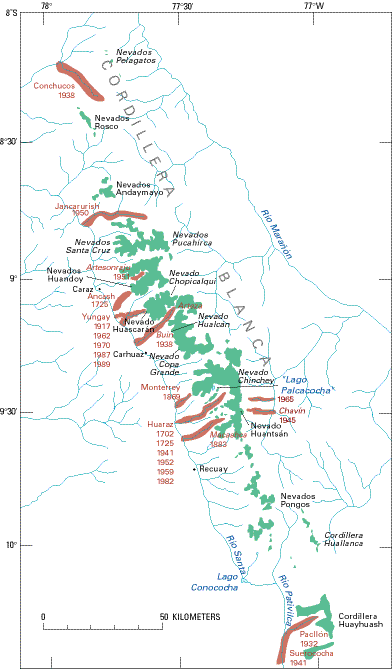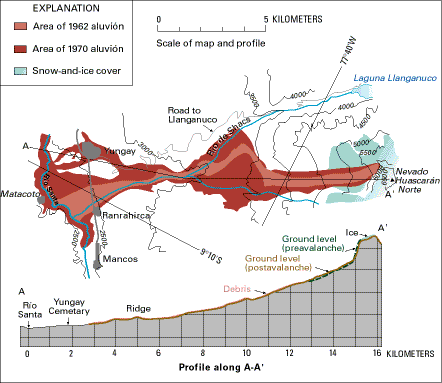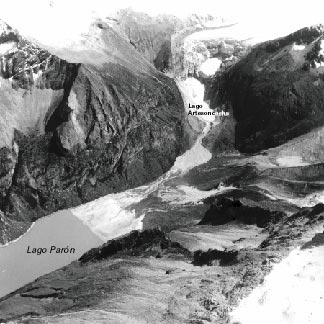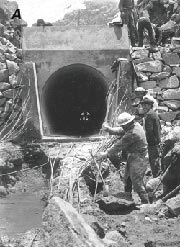
Glacier Hazards
Since 1702, more than 22 catastrophic events have resulted from ice avalanches that have caused outburst floods from glacier lakes. The floods, known in Perú as aluviónes, come with little or no warning and are composed of liquid mud that generally transports large rock boulders and blocks of ice. The floods have destroyed a number of towns, and many lives have been lost (table 4). One of the hardest hit areas has been the Río Santa valley in northern Perú (fig. 11). Of these catastrophes, the most serious were the aluviónes that destroyed part of the city of Huaraz in 1725 and 1941, as well as the aluvión that resulted from the failure of Lago Jancarurish in 1950. In addition, two destructive, high-speed avalanches from the summit area of Huascarán Norte (6,655 m asl) in 1962 and 1970 destroyed several villages and caused the deaths of more than 25,000 inhabitants. Reports of these catastrophic glacier-related events include those by Morales Arnao, B., (1966, 1971), Chiglino (1950, 1971), Lliboutry (1975), Plafker and Ericksen (1978), and Hofmann and others (1983). Figures 6 and 12 give some idea of the effect of the Huascarán avalanches. Figure 13 shows the 1951 flood from Lago Artesoncocha into Lago Parón.
Figure 11.--The locations of the many natural disasters, glaciological in origin, that have caused deaths or property damage in the Río Santa valley of Perú since 1702. See table 4 for additional information.

Table 4.--Natural disasters in Perú that were glaciological in origin (see fig. 11)
|
No.
|
Cordillera
|
Area
|
Description
|
Date
|
|
1
|
Blanca
|
Huaraz
|
Floods destroyed part of the city of Huaraz.
|
4 March 1702
|
|
2
|
Blanca
|
Huaraz
|
Earthquake, ice avalanche, and floods damaged the city of Huaraz. Approximately 1,500 people were reported missing; only 300 people were left alive.
|
6 January 1725
|
|
3
|
Blanca
|
Yungay
|
Avalanche from Nevados Huandoy. Floods destroyed the town of Ancash, and 1,500 people were reported to have perished. At the same time, an earthquake also took place.
|
6 January 1725
|
|
4
|
Blanca
|
Huaraz
|
Slides and floods affected the village of Monterrey, destroying houses and fields; 11 people missing.
|
10 February 1869
|
|
5
|
Blanca
|
Huaraz
|
Flood in the town of Macashca. Many people were reported to have died. Rajucolla levee was broken.
|
24 June 1883
|
|
6
|
Blanca
|
Yungay
|
Ice avalanche from Huascarán impacted Shacsha and Ranrahirca.
|
22 January 1917
|
|
7
|
Huayhuash
|
Bolognesi
|
Aluvión from Lago Solteracocha in the Pacllón basin.
|
14 March 1932
|
|
8
|
Blanca
|
Carhuaz
|
Aluvión from Lago Arteza (Pacliashcocha) into the Quebrada Ulta (Río Buin) near Carhuaz (Kinzl, 1940).
|
20 January 1938
|
|
9
|
Blanca
|
Pallasca
|
Aluvión from Lago Magistral affected the town of Conchucos.
|
1938
|
|
10
|
Huayhuash
|
Bolognesi
|
Aluvión from Lago Suerococha impacted Río Pativilca causing damage to agricultural fields and town of Sarapo.
|
20 April 1941
|
|
11
|
Blanca
|
Huaraz
|
Aluvión from Lago Palcacocha damaged the city of Huaraz. Approximately 5,000
people died. The new part of the city was destroyed.
|
13 December 1941
|
|
12
|
Blanca
|
Huari
|
Aluvión from Lagos Ayhuinaraju and Carhuacocha caused by an ice avalanche from the Huantsan peak damaged the town of Chavín. Many people died.
|
17 January 1945
|
|
13
|
Blanca
|
Huaylas
|
Aluvión from Lago Jancarurish above the Los Cedros drainage basin. Destruction of the Central Hidroeléctrica del Cañón del Pato, the highway, and part of the railway from Chimbote to Huallanca.
|
20 October 1950
|
|
14
|
Blanca
|
Huaylas
|
Aluvión from Lago Artesoncocha into Lago Parón (two events).
|
16 June and 28 October 1951
|
|
15
|
Blanca
|
Huaraz
|
Aluvión from Lago Milluacochan into the Quebrada Ishinca drainage basin.
|
6 November 1952
|
|
16
|
Blanca
|
Huaraz
|
Slides and flood from Lago Tullparaju affected Huaraz city.
|
8 December 1959
|
|
17
|
Blanca
|
Yungay
|
Avalanches and aluviónes from Huascarán Norte. About 4,000 people died; 9 towns were destroyed, one of which was Ranrahirca (Dollfus and Peñaherrera del Aguila, 1962; Morales Arnao, 1962).
|
10 January 1962
|
|
18
|
Blanca
|
Huari
|
Ice avalanche from Nevado San Juan above Lago Tumarina (Quebrada Carhuascancha, Huantar District); 10 people died in Chavín.
|
19 December 1965
|
|
19
|
Blanca
|
Yungay
|
Rock and ice avalanche from Huascarán Norte severely affected the city of Yungay. Approximately 23,000 people died. The same day another avalanche took place between Lagunas Llanganuco.
|
31 May 1970
|
|
20
|
Blanca
|
Huaraz
|
Small avalanche from Tocllaraju near Paltay into Lago Milluacocha.
|
31 August 1982
|
|
21
|
Blanca
|
Yungay
|
Small ice avalanche from Huascarán Norte reached the Ranrahirca fan.
|
16 December 1987
|
|
22
|
Blanca
|
Yungay
|
Small ice avalanche from Huascarán Norte reached the Río Santa.
|
20 January 1989
|
Figure 12.--Sketch map and profile of the area affected by the 1962 and 1970 aluviónes from Huascarán Norte in the Cordillera Blanca (modified from Plafker and Ericksen, 1978). See also figure 6.

Figure 13.--Flood from Lago Artesoncocha (1951) into Lago Parón in the Cordillera Blanca near Caraz.

These catastrophes influenced the Government of Perú to establish an Oficina de Obras Seguridad (Security Works Office) to prevent or mitigate avalanches and floods from glacial lakes. Several glacial lakes have been drained by using two traditional methods, the first by excavating a channel through the morainic dam and the second by building tunnels through the moraine. Where the first method is employed, a channel through the top of the moraine is gradually and carefully excavated so that the water behind the dam is allowed to drain safely through the channel and into the stream below. When the water is drained to the desired level, a permanent concrete drainage pipe is constructed within the moraine. Next, the moraine is rebuilt to its original level by using compacted earth, which is covered in turn by rock and concrete. The permanent outlet provides drainage and a normally low water level, whereas the dam provides protection in case of avalanches and floods. The second method digs or drills tunnels through the morainic dams or surrounding rock; the tunnels are left open to prevent the glacier lakes from forming in the future. In both methods, great care must be taken to prevent uncontrolled drainage of the lake because of the possibility of catastrophic flooding. Construction is difficult because most sites are situated at elevations of 4,000 m or higher.
The first method was used successfully on Lago Llaca and Lago Shallap above Huaraz and on Lago Hualcacocha above Carhuaz (figs. 3, 14). The second method was used on the moraines of Lago Tullparaju above Huaraz and Lago Safuna, northwest of Nevados Pucahirca, and in the drilling of the Parón Tunnel above Caraz through granitic rock 50 m below the water surface, as well as the tunnels on 513 lakes above Carhuaz (fig. 3).
After more than 30 years of continuous work, the program appears to be successful because no destructive floods resulting from the breakout of glacial lakes have occurred in the Cordillera Blanca since 1972.
U.S. Geological Survey, U.S.Department of the Interior
This page is https://pubs.usgs.gov/prof/p1386i/peru/hazards.html
Contact: Richard S. Williams, Jr., and Jane G. Ferrigno
Last modified 02.09.99





